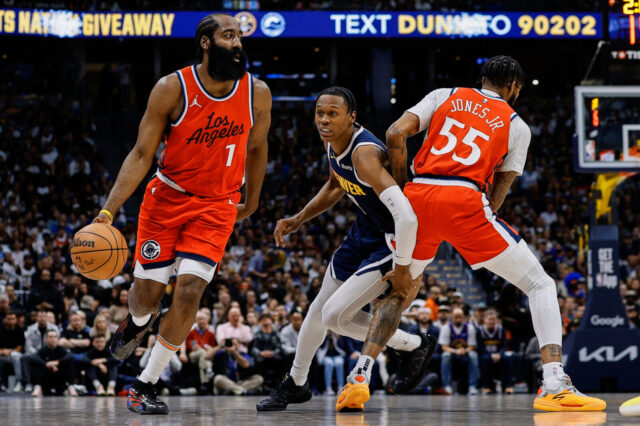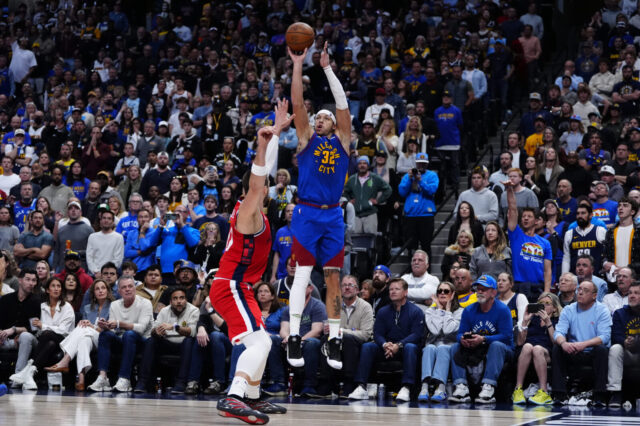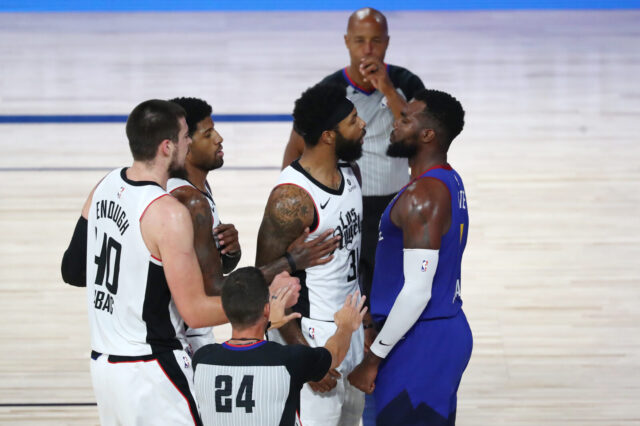On Monday, our own Brandon Ewing ranked his top 20 guards in the 2021 NBA Draft pool. With Cade Cunningham at the top, Chris Duarte making a surprise appearance behind Jalen Green and Jalen Suggs, and my favorite target in Denver’s draft range, Miles “Deuce” McBride, falling all the way down to 13th, Brandon provided some really great content. I hope everyone checks it out before or after they read onto my thoughts on the next position group.
As Brandon mentioned, most of the players mentioned are ones we feel comfortable discussing as what we believe to be surefire selections in the draft this year. Internally at Denver Stiffs, we have graded the top 20 guards, top 15 wings/forwards, and top 10 bigs as having at least an outside chance to crack the first round this year. Sitting at 26th overall, these felt like the right positional cutoffs to generate a list of about 45 names to discuss prior to next Thursday’s NBA Draft. Brandon covered the guards on Monday. I have the wings/forwards today. Tomorrow will feature the bigs of the class.
I expect the Nuggets to select a player from Brandon’s list on draft night; however, it wouldn’t surprise me if one or two of the names on this list ended up becoming a Nugget by night’s end next week, particularly in the middle of the list. Let’s talk about the prospects!
If you don’t see a name that you thought you might see, check out Brandon’s list of the top 20 guards on Monday, as it’s possible that a player like Cade Cunningham, Keon Johnson, or Ziaire Williams was covered in that list.
1. Scottie Barnes
The questions about Scottie Barnes developing a jumper are real. Despite being an impactful all-around freshman at Florida State with unique playmaking and vision at 6’9” and 230 pounds, Barnes shot poorly outside the paint and at the free throw line. To be a primary playmaker in the NBA at his size, it’s still important to have a reliable jumper. Just ask Ben Simmons.
Despite that, it’s clear that Barnes has exceedingly high potential, especially on the defensive end of the floor. Barnes was used to defend many point guards, and he has the size, strength, and acumen to switch up and down the lineup defensively. Don’t let the pedestrian per game numbers fool you: Barnes has very clear star potential in the right situation.
Draft Grade: Top-5 pick
PPG: 10.3
AST: 4.1
REB: 4.0
3P%: 27.5%
2P%: 56.1%
2. Jonathan Kuminga
Kuminga decided to go the G-League route along with Jalen Green and Isaiah Todd (more on him late) to help develop his game while facing pro level competition. The shooting percentages were not very impressive, but the physicality and potential he showed on film should be more than enough to see him go Top-10 in this draft, maybe even Top-5. At 6’8” and extremely athletic, Kuminga is touted as a possible star scorer at the next level, and it’s easy to see why. Whether he can become refined enough as a playmaker and decision maker will be the swing factor for his stardom.
Draft Grade: Top-10 pick
PPG: 15.8
AST: 2.7
REB: 7.2
3P%: 24.6%
2P%: 46.3%
3. Josh Giddey
Josh Giddey is a unique playmaking wing prospect who played point guard for the Adelaide 36ers in the NBL and put up Lonzo Ball type numbers. Giddey showcased great playmaking vision and scoring off the dribble when going downhill in the pick and roll. He was also the leading rebounder on the team which, as a 6’7” young and skinny point guard, is pretty impressive. He will be a great playmaker for others at the next level.
He wasn’t a great defender, which isn’t surprising as skinny as he was. He will need to rework his jumper form as well, as the ball is shot from in front of his face in an awkward motion.
Draft Grade: Top-10 Pick
PPG: 10.9
AST: 7.5
REB: 7.4
3P%: 29.3%
2P%: 50.6%
4. Franz Wagner
Franz Wagner helped lead Michigan deep into the NCAA tournament as a sophomore. He’s German, and his brother, Moritz, plays the NBA already. He’s a good athlete with a versatile skill set, showcasing an ability to create off the dribble for himself and others while also defending at a reasonably high level. He isn’t a primary playmaker, but he makes some pretty impressive passes and moves well with the ball in his hands.
His role at the next level will be interesting, but it’s clear that he’s a good player and will impact games in a variety of ways. His feel for the game is good, and a smart team will find a way to maximize what he does well . Wagner is a little thin and will need to develop physically, but already standing at 6’9”, he projects to be a unique combo forward at the next level.
Draft Grade: Lottery Pick
PPG: 12.5
AST: 3.0
REB: 6.5
3P%: 34.3%
2P%: 56.3%
5. Moses Moody
Moses Moody is a freshman from Arkansas who, at 6’6” in shoes with a near 7’1” wingspan, has the physical tools to be the next elite complementary wing. Moody’s jump shot is mostly great in catch-and-shoot situations, though he struggles a bit with self-creation off of movement. He isn’t a creator for others, but as a complementary option, he wouldn’t be asked to do that as much. Put him next to other elite creators and he can grow into an off-ball role offensively.
Defensively, Moody isn’t quite the athlete Barnes and Kuminga are, but his length and ability to move his feet side to side make him a great option defending in isolation situations. He isn’t always pestering opponents while off-ball, but whether he’s guarding smaller or bigger players, Moody does a great job preventing easy shots. He will be a plus defender at the next level.
Draft Grade: Lottery pick
PPG: 16.8
AST: 1.6
REB: 5.8
3P%: 35.8%
2P%: 47.8%
6. Corey Kispert
Perhaps the safest pick in the entire draft class, Corey Kispert flourished as the leading scorer at Gonzaga with an offensive game eerily reminiscent of Joe Harris. The level of shooting effectiveness he showed all over the court highlighted just how valuable an elite off-ball shooter can be by bending the defense in various ways. Opponents get into his airspace but allow driving and passing lanes for others, and a well timed dribble move by Kispert freed up plenty of space too. He won’t be an elite scorer at the next level from a volume perspective, but he has all of the tools and the shot profile to be a lethal three-point shooter. At 6’7” and 220, Kispert should be able to hold up in different matchups defensively, though not as a primary on-ball option.
Draft Grade: Mid first
PPG: 18.6
AST: 1.8
REB: 5.0
3P%: 44.0%
2P%: 62.8%
7. Jalen Johnson
Jalen Johnson had an…inconsistent 13 games at Duke that saw him flash immense potential, highlight problematic areas, deal with a foot injury for a month, get benched after a couple of inconsistent performances, and then with Johnson walking away from Duke entirely after just 13 games played. After walking away from IMG Academy in high school, that raises some red flags, and though the Nuggets have been unafraid to go after players with red flags before, it remains a concern.
On the court, Johnson is physically dominant when he wants to be and inconsistent when he isn’t locked in. He’s a menace in the open floor when he gets a head of steam, and the 2.1 assists per game don’t fully capture his passing acumen. At 6’9” in shoes with a 7’0” wingspan, Johnson also had the biggest hands at the NBA Draft combine for what it’s worth. The three-point percentage is good, but he isn’t that level of shooter in reality and will have to improve his jumper.
Draft Grade: Mid to late first
PPG: 11.2
AST: 2.1
REB: 6.1
3P%: 44.4%
2P%: 53.8%
8. Trey Murphy
Trey Murphy was one of the best catch-and-shoot big wings in the country last year. When he had time to get his balance and square up to the hoop, he was lethal. He also showcased some incredible athleticism on cuts and in transition, throwing down some seriously impressive dunks above the rim and through contact. He will need to be more than just a standstill shooter and occasional cutter at the next level, but there’s a solid foundation to fall back upon. Murphy shot 92.7% from the free throw line as well, though on a small sample.
Defensively, there are very few players in the country who can match the combination of Murphy’s length, athleticism, and tenacious mindset on-ball. At 6’9” in shoes and with a 7’0” wingspan, most teams decided to avoid Murphy as much as they could, and few teams would go at him at the NBA level if they could avoid it.
Draft Grade: Mid to Late first
PPG: 11.3
AST: 1.2
REB: 3.4
3P%: 43.3%
2P%: 62.0%
9. Quentin Grimes
Quentin Grimes started his career as a high profile recruit at Kansas. It didn’t work out, and Grimes transferred to Houston the next year where he worked on his game and improved immensely. This year, his junior season, Grimes won AAC player of the year while averaging 17.8 points and shooting 40.3% from three on 8.3 attempts per game. Though he’s mostly a high volume three-point shooter, Grimes has also shown the flashes of a dribble drive game as a playmaker for himself and others. In addition, he’s a strong defensive player, standing at 6’5” in shoes with a 6’8” wingspan. He’s strong enough and mobile enough to guard most point guards, shooting guards, and small forwards. Most will call him a 3&D shooting guard at the next level, and there’s definitely a role for that.
Draft Grade: Late first, early second round
PPG: 17.8
AST: 2.0
REB: 5.7
3P%: 40.3%
2P%: 41.0%
10. Jeremiah Robinson-Earl
Jeremiah Robinson-Earl has already worked out for the Denver Nuggets, and it’s easy to see why the Nuggets have shown interest. A two-year player at Villanova, the last seven Wildcats players selected in the NBA draft have been Saddiq Bey, Eric Paschall, Mikal Bridges, Donte DiVincenzo, Omari Spellman, Jalen Brunson, and Josh Hart. Almost all are strong role players, and Robinson-Earl could be the next Wildcat in that mold.
At 6’9” and 230 pounds, there is some Grant Williams in his game. He’s a fundamental power forward with defensive switching skills, a high basketball IQ, and definite role player potential in the modern NBA with the downsizing on second units. He likely isn’t athletic enough to consistently play small forward though, and that probably limits his ceiling. Robinson-Earl will make a team outside the lottery happy though while other players fail around him. He’s still set up for success. He will have to push that mid-range jumper out to three-point territory though.
Draft Grade: Late first, Early second
PPG: 15.7
AST: 2.2
REB: 8.5
3P%: 28.0%
2P%: 57.4%
11. Kessler Edwards
Kessler Edwards is a unique prospect from Pepperdine. At 6’8” and a 6’11” wingspan, there’s no question that Edwards can shoot the basketball despite an awkward shooting form. He was at his best in catch-and-shoot situations on the perimeter, but he also utilized an effective post game against mismatches. He wasn’t a creator for others but muscled and shot his way to a strong season. Whether he can guard at the highest level remains to be seen, but he has the physical attributes to at least be a solid defender.
Draft Grade: Early second round
PPG: 17.2
AST: 1.2
REB: 6.8
3P%: 37.8%
2P%: 55.3%
12. Aaron Henry
Aaron Henry led Michigan State in points, rebounds, assists, and steals in his junior season. He was second in blocks as well, and his efforts on the defensive end of the floor were some of the most impressive in the country. Henry quite literally did everything for the Spartans except hit outside jumpers at a high rate, though he has decent touch and could absolutely improve his efficiency in a lesser role at a higher level. He’s a sneaky target in the second round.
Draft Grade: Early second round
PPG: 15.4
AST: 3.6
REB: 5.6
3P%: 29.6%
2P%: 49.3%
13. Brandon Boston Jr.
Brandon Boston Jr. was an inefficient scorer for what was a really poor Kentucky team this year. Standing at 6’7” in shoes with a nearly 6’11” wingspan, Boston’s fluidity and dribble drive game stands out for his size. Though the shots didn’t go down, Boston was often able to navigate driving lanes well and get into the paint while the floor was spaced. Still, there are concerns about his scoring efficiency, as well as his fundamentals on both ends of the floor.
There were some extenuating circumstances affecting Boston this year, but he frankly wasn’t great. Front offices will have to rely on his high school talent shining through after ranking as the fourth best recruit in the 2020 draft class, according to the RSCI. Measuring at 188 pounds at the combine, Boston has a lot of development left to go. He may look like a different player with 20 additional pounds of muscle and more playing experience overall. He’s worth a flyer in the second round.
Draft Grade: Mid second round
PPG: 11.5
AST: 1.6
REB: 4.5
3P%: 30.0%
2P%: 38.4%
14. Herb Jones
Herb Jones arrived in Alabama the same season that Collin Sexton played is only season. While Sexton went on to be a top 10 pick in the 2018 draft, Jones stayed to hone his talents at Alabama to strong results. He won SEC player of the year and SEC defensive player of the year this past season while playing mostly power forward. He was highly switchable, wreaked havoc in the passing lanes, and also blocked shots at a solid clip. Standing at 6’7” in shoes with a 7’0” wingspan certainly helped him out.
There aren’t many questions about his defensive abilities, but the offense is a different story. He’s clearly a good passer, and he shot 35.1% from three as a senior. He’s a career 28.8% three-point shooter though, and the career 60.4% free throw shooting does little to inspire confidence. He might be able to pass, but he won’t make it as a 3&D role player. Whichever team selects him will have to figure out a different path.
Draft Grade: Second round
PPG: 11.2
AST: 3.3
REB: 6.6
3P%: 35.1%
2P%: 47.0%
15. Joe Wieskamp
Joe Wieskamp was one of the best shooters in college basketball last year. Playing off of powerful big man Luka Garza’s inside-outside game, Wieskamp used screens, hand-offs, and scramble situations to find and make three-pointers consistently. He’s a confident shooter and will hit heavily contested shots as well, as long as he can get squared up to the basket. There’s some ability to create for himself and others but not enough to warrant first round consideration. In addition, his slender 6’6” frame made him vulnerable to better athletes or switches at times defensively.
Draft Grade: Second round
PPG: 14.8
AST: 1.7
REB: 6.6
3P%: 46.2%
2P%: 51.8%


